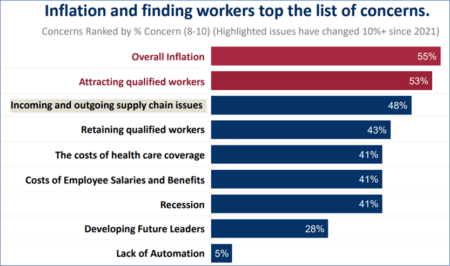Year-end is the traditional time when manufacturers and other business entities s try to conduct productive employee performance reviews. Unfortunately, reviews are often done as quickly as possible, with little thought given to providing the type of feedback to employees that will ultimately help the company achieve its strategic goals. It’s also important to allow employees to respond and provide their own feedback. Doing so can lead to greater worker satisfaction and increased productivity.
According to the 2022 State of Manufacturing Survey conducted by Enterprise Minnesota, over 400 manufacturing executives ranked attracting and retaining qualified workers as some of their top concerns. Employee reviews are an opportunity to deliver fair and actionable assessments to employees, leading to an increase in employee engagement, strong recognition and encouragement, and a tangible path for employee growth.

Here are some suggestions on how manufacturers can conduct productive employee reviews:
Objective vs. Subjective Review
While the particulars vary from company to company, an employee review generally is a formal assessment of the worker’s performance over the review period, including evaluations of strengths, weaknesses and overall activity. The review is documented and placed in the employee’s HR file.
Technology can facilitate better tracking and monitoring of an employee’s output. This can be especially important when it comes to assessing remote workers.
Taking this into account, the performance review may be objective or subjective — or a combination of both. An objective review goes strictly by the numbers, based on data. Automated processes can eliminate the guesswork. An objective review may include:
- Units produced in comparison to other employees,
- Average time for units produced,
- Relation to the company’s expectations, and
- Time spent on manufacturing activities.
A subjective review, on the other hand, requires input from sources such as an assembly line supervisor or a department head. This type of review may include:
- Willingness to work as part of the team,
- Strengths and weaknesses,
- Flexibility,
- Ability to meet company standards, and
- General attitude and performance.
Either method may prove adequate, but manufacturers will generally find that a combination of the two is optimal because it paints the big picture of an employee’s performance.
Benefits of Comprehensive Reviews
Conducting comprehensive employee performance reviews can be challenging to manufacturing managers. They require significant effort, and the potential for conflict exists if an employee is offended or disagrees with the assessments. But it can otherwise be a rewarding experience that provides valuable insights.
A review can foster efficiency if employees take constructive feedback to heart. By learning about areas in need of improvement, workers can refocus efforts to sharpen their skills. Also, if you offer clear advice or instruction going forward, your employees are more likely to meet companywide objectives.
Positive feedback in reviews can boost morale and make employees feel appreciated and inspired to continue to perform at a high level for the next year. This often results in a better workplace environment.
However, don’t discount the employee’s side of the process. The review is an opportunity for employees to discuss personal needs and what they view as obstacles to achieving the company’s goals. Remote workers may especially benefit from this additional communication.
Five Strategies for Success
Consider these five strategies for improving your manufacturing company’s performance review process:
- Set employee expectations. All too often, employees aren’t exactly sure what the review is supposed to cover. For that reason, they tend to hold back. If pressed on a particular issue, they might become defensive. Conversely, if you establish an agenda before meeting with employees so that they can anticipate what will be discussed, the evaluation will likely be more productive.
- Keep it simple. Frequently, the most effective reviews are ones that eliminate much of the extra noise. The primary goal should be to try to help employees realize their potential. Don’t get sidetracked by too many peripheral issues. If you find yourself veering off, get right back on track.
- Make the review a collaboration. The review path shouldn’t be a one-way street. Provide employees the time to present their own long-term objectives and see how they align with your manufacturing company’s needs. Furthermore, ask employees about obstacles they’re facing and what can be done to eliminate or, at least, minimize them.
- Present both sides of the coin. Although you may have to discuss some negatives, don’t turn the review into a complete downer. Balance any “bad news” with some “good news” about the employee’s achievements. Rely on the metrics, but take a well-rounded approach to the meeting. In addition, highlight any milestones that the employee reached during the year.
- Develop a plan of action. Don’t just throw a bunch of suggestions against a wall and see what sticks. Lay out a plan, preferably in writing, that points employees in a direction that you want them to go. Offer to meet at regular intervals to assess progress. This will help you align your expectations with those of your employees.
Avoid the Pitfalls
Employee performance reviews can be a win-win situation for employers and employees, but there are potential pitfalls. Take the time to ensure that your reviews are meaningful. Doing more than just going through the motions year-in and year-out can pay off in the long term. The Olsen Thielen Manufacturing Team is ready to help your manufacturing company develop a meaningful program for conducting productive employee reviews–contact us for more ideas.
